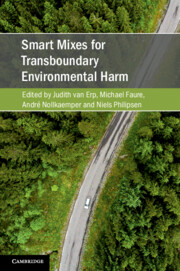12 results
Contents
-
- Book:
- Smart Mixes for Transboundary Environmental Harm
- Published online:
- 15 March 2019
- Print publication:
- 28 March 2019, pp vii-viii
-
- Chapter
- Export citation
Figures
-
- Book:
- Smart Mixes for Transboundary Environmental Harm
- Published online:
- 15 March 2019
- Print publication:
- 28 March 2019, pp ix-x
-
- Chapter
- Export citation
Tables
-
- Book:
- Smart Mixes for Transboundary Environmental Harm
- Published online:
- 15 March 2019
- Print publication:
- 28 March 2019, pp xi-xii
-
- Chapter
- Export citation
Part II - Fisheries and Forestry
-
- Book:
- Smart Mixes for Transboundary Environmental Harm
- Published online:
- 15 March 2019
- Print publication:
- 28 March 2019, pp 95-236
-
- Chapter
- Export citation
Part I - Conceptual Approaches to Smart Mixes
-
- Book:
- Smart Mixes for Transboundary Environmental Harm
- Published online:
- 15 March 2019
- Print publication:
- 28 March 2019, pp 1-94
-
- Chapter
- Export citation
Part IV - Concluding Remarks
-
- Book:
- Smart Mixes for Transboundary Environmental Harm
- Published online:
- 15 March 2019
- Print publication:
- 28 March 2019, pp 327-328
-
- Chapter
- Export citation
Part III - Climate Change and Oil
-
- Book:
- Smart Mixes for Transboundary Environmental Harm
- Published online:
- 15 March 2019
- Print publication:
- 28 March 2019, pp 237-326
-
- Chapter
- Export citation
Contributors
-
- Book:
- Smart Mixes for Transboundary Environmental Harm
- Published online:
- 15 March 2019
- Print publication:
- 28 March 2019, pp xiii-xiv
-
- Chapter
- Export citation
Copyright page
-
- Book:
- Smart Mixes for Transboundary Environmental Harm
- Published online:
- 15 March 2019
- Print publication:
- 28 March 2019, pp vi-vi
-
- Chapter
- Export citation
Acknowledgments
-
- Book:
- Smart Mixes for Transboundary Environmental Harm
- Published online:
- 15 March 2019
- Print publication:
- 28 March 2019, pp xv-xvi
-
- Chapter
- Export citation
Abbreviations
-
- Book:
- Smart Mixes for Transboundary Environmental Harm
- Published online:
- 15 March 2019
- Print publication:
- 28 March 2019, pp xvii-xxii
-
- Chapter
- Export citation

Smart Mixes for Transboundary Environmental Harm
-
- Published online:
- 15 March 2019
- Print publication:
- 28 March 2019



